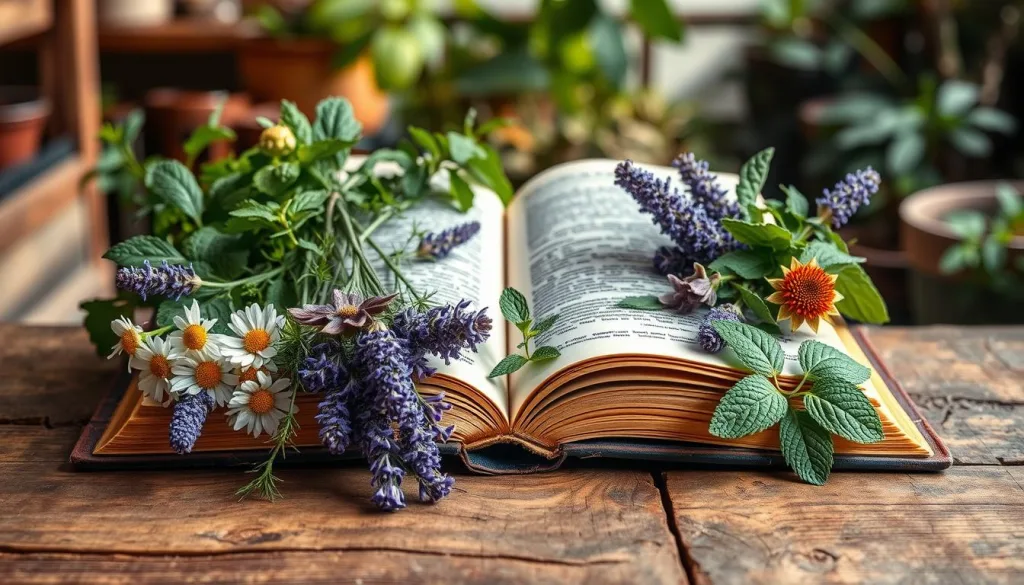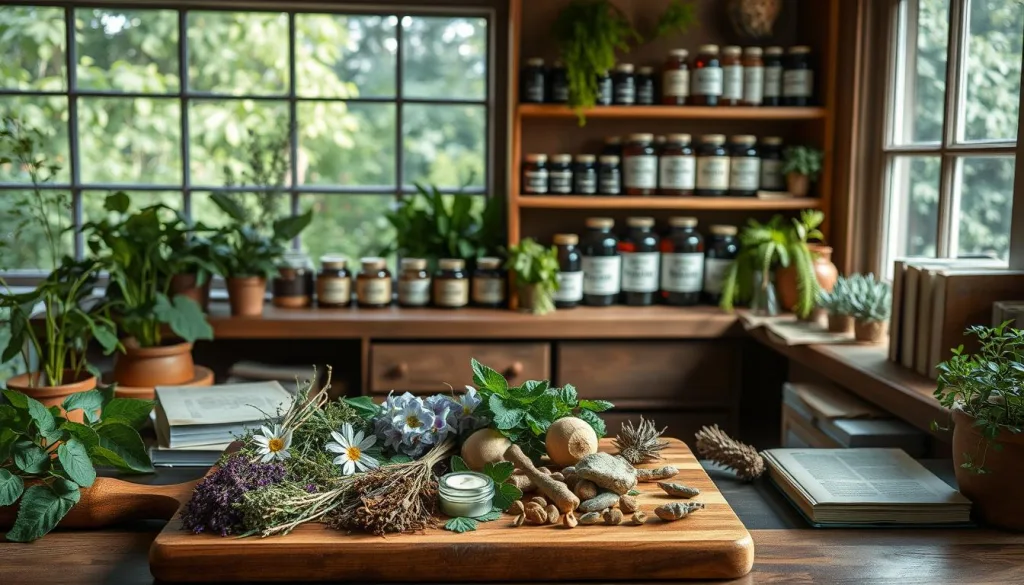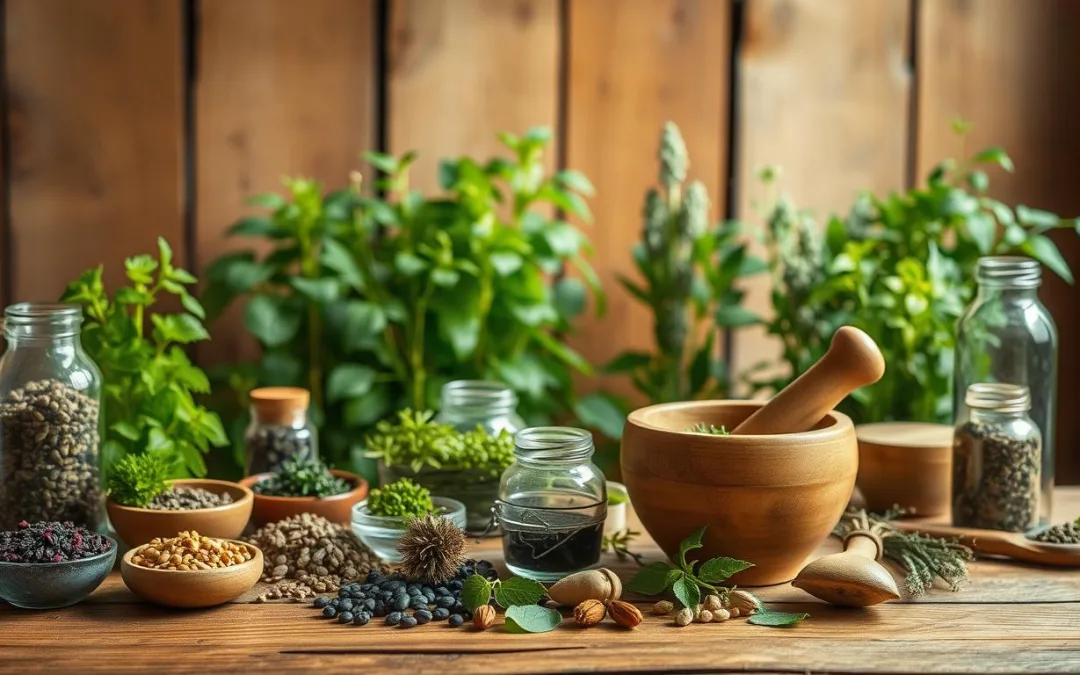Welcome to the world of herbal medicine preparation. More people are turning to natural remedies instead of traditional drugs. In 2007, 38% of adults in the US used traditional medicine, with herbal therapy being the most popular at 18.9%.
I started exploring herbal medicine because I was curious about plants’ healing powers. This guide will show you how to make safe and effective natural remedies at home. We’ll look at how to choose, find, and prepare herbal treatments for better health.
Learning about herbal medicine is more than just mixing stuff. It’s about connecting with old healing traditions and using modern science. The global herbal products market is now over US$60 billion, showing how much people want these plant-based solutions.
Key Takeaways
- Herbal medicine offers a natural approach to health and wellness
- Nearly 40% of adults in the US have explored alternative medicine
- Proper preparation is key for effective herbal remedies
- Always check with healthcare professionals before starting any new treatment
- Quality and where you get your herbs from are very important for safety and effectiveness
Understanding the Basics of Herbal Medicine
Herbal medicine is a blend of old wisdom and new health care. It has been around for over 5,000 years. Today, about 80% of the world’s people use herbal medicines for health.
What Are Herbal Remedies?
Herbal remedies come from plants. They use parts like leaves, roots, and seeds. People have used them for health issues for a long time. Nearly one-third of Americans use herbal remedies, showing they’re popular today.
- Natural plant-based treatments
- Extracted from different plant components
- Used for preventive and therapeutic purposes
The History of Traditional Herbal Medicine
Herbal medicine has a long history worldwide. It includes Ayurveda in India and Traditional Chinese Medicine. In many places, people use plants for health care.
| Region | Herbal Medicine Prevalence | Key Characteristics |
|---|---|---|
| India | 80% population treated by Ayurvedic doctors | Holistic approach to healing |
| Germany | 70% physicians prescribe plant-based medicines | Integrated medical approach |
| United States | 50% adults use herbal supplements | Growing acceptance of natural treatments |
Benefits and Limitations of Herbal Treatments
Herbal medicine has many benefits. Studies show that herbs work well because of their whole plant parts. For example, echinacea can cut cold odds by 58% and shorten colds by 1.4 days.
Remember, while herbal remedies offer promising health solutions, they should be used responsibly and in consultation with healthcare professionals.
It’s important to know that herbal supplements aren’t as closely watched as drugs. The FDA checks their making and labels. But, users should be careful and talk to doctors first.
Essential Tools and Equipment for Herbal Medicine Preparation
Starting your DIY herbal medicine journey means getting the right tools. You’ll need special equipment that’s different from what you use in the kitchen. This ensures your herbal remedies are pure and work well.
Here are the key tools every herbalist needs for their workspace:
- Mortar and pestle (used by 100% of herbalists for grinding herbs)
- Dark glass dropper bottles (preferred by 85% of practitioners)
- Cheesecloth for straining
- Graduated cylinders for precise measurements
- Kitchen scale (digital recommended)
Key Equipment for Herbal Preparation
When you set up your DIY herbal medicine station, get specialized tools. These tools help you prepare safely and effectively. Having a dedicated space keeps your herbal recipes clean and pure.
| Tool | Usage Percentage | Primary Function |
|---|---|---|
| Double Boiler | 90% | Melting waxes and infusing oils |
| Glass Jars | 95% | Storing herbs and finished preparations |
| Sprouting Screens | 80% | Creating herbal infusions |
Pro Tip: Always use separate tools for herbal medicine preparation. This keeps things clean and prevents contamination. Stainless steel, glass, and ceramic are best for most herbal crafting.
Remember, your herbal medicine toolkit is an investment in your health. Start with the basics and add more as you learn to make herbal medicine recipes.
Selecting and Sourcing Quality Herbs
Starting a herbal remedies guide means picking the right herbs. Not all herbs are the same. Choosing the best ones is key for safe and effective remedies.
Finding the right herbs in the herbal world is tricky. The strength of herbal medicines depends on several things:
- Growing conditions
- Harvest timing
- Plant parts used
- Storage methods
- Freshness
Identifying Reliable Herb Sources
When looking for herbs, choose trusted suppliers. They should share how they grow and harvest their herbs. Look for those who focus on medicinal herbs and give detailed product info.
Understanding Herb Quality Certifications
USDA certification is important for herbs in North America. It means herbs are:
- Free from pesticides
- Chemical fertilizer-free
- Non-GMO
- Without synthetic chemicals
Sustainable Harvesting Practices
Good herbal medicine does more than help you. It also protects the environment. Sustainable harvesting keeps plants healthy and available for future use.
The art of herbal medicine is as much about respecting nature as it is about healing.
Tip for your herbal guide: Check the shelf life and storage of your herbs. Dried herbs like leaves and flowers last a year. Roots and seeds can last up to two years.
Common Medicinal Herbs for Beginners

Exploring herbal remedies is an exciting journey into plant-based healing. I’ll introduce you to several powerful herbs that are perfect for beginners interested in natural wellness.
Understanding the power of herbal medicine requires careful research and responsible use. The FDA monitors herbal supplements, but they aren’t regulated as strictly as prescription medications. Always consult with healthcare professionals before starting any new herbal treatment.
- Chamomile: A gentle herb known for promoting relaxation and reducing anxiety
- Helps with sleep issues
- Supports wound healing
- Provides antioxidant benefits
- Ginger: A versatile herb with multiple health applications
- Reduces nausea
- Supports digestive health
- Helps manage chemotherapy-related symptoms
- Turmeric: A powerful anti-inflammatory plant-based remedy
- Contains potent antioxidants
- Supports joint health
- Potential anticancer properties
“Nature provides powerful healing tools when used with knowledge and respect.” – Integrative Medicine Practitioner
When adding herbal remedies to your wellness routine, start with small doses and watch how your body reacts. Each person’s response to plant-based treatments can vary. So, be patient and observe carefully.
Remember, herbal medicines offer promising health benefits but are not miracle cures. They work best as part of a complete health approach. This includes proper nutrition, exercise, and medical guidance.
Herbal Medicine Preparation Methods and Techniques
Exploring traditional herbal medicine requires precision and respect for plants. Herbal medicine preparation uses various techniques to extract plant properties effectively.
Each extraction method helps create herbal remedies for different health needs. Let’s look at the main techniques used:
Herbal Tincture Techniques
Tinctures are strong liquid extracts made with alcohol. The process includes:
- Selecting high-quality dried or fresh herbs
- Choosing an appropriate alcohol percentage (40-90%)
- Maintaining precise herb-to-solvent ratios
- Storing in dark glass containers
Herbal Infusion Methods
Herbal infusions are gentle methods for extracting from leaves and flowers. There are two main ways:
- Hot infusions: Steeping herbs in boiling water
- Cold infusions: Soaking herbs in room temperature water
Herbal Decoction Processes
Decoctions are best for extracting from tough materials like roots and bark. The process involves:
| Step | Description |
|---|---|
| 1. Preparation | Chop or grind hard plant materials |
| 2. Extraction | Simmer in water for 15-30 minutes |
| 3. Straining | Remove plant materials, retain liquid |
Knowing these traditional herbal medicine preparations helps make effective, natural remedies. It ensures safety and potency.
Safety Considerations and Precautions

Herbal remedies guide us toward natural healing, but safety is key. Not all natural treatments are risk-free. About 25% of modern medicines come from plants, but that doesn’t mean they’re safe.
“Natural” does not automatically mean safe or harmless.
When looking into herbal medicine benefits, there are important safety factors to consider:
- Potential interactions with prescription medications
- Risk of unexpected side effects
- Proper dosage management
- Individual health condition considerations
Certain groups need extra care when using herbal treatments:
- Pregnant women
- Individuals with chronic health conditions
- People taking multiple medications
- Elderly patients
- Children
The global herbal medicine market is worth about USD 100 billion. Yet, popularity doesn’t eliminate risks. Around 80% of the world’s population uses herbal medicines, making safety awareness essential.
| Population Group | Herbal Medicine Precautions |
|---|---|
| Pregnant Women | Consult healthcare provider before use |
| Medication Users | Check for drug interactions |
| Chronic Illness Patients | Professional medical guidance required |
Always buy herbs from trusted suppliers. Talk to a qualified healthcare professional about your herbal medicine plan. This ensures safe and effective treatment.
Storage and Preservation of Herbal Preparations
Keeping your herbal medicine recipes potent needs careful storage and preservation. DIY herbal medicine requires attention to detail. This ensures the therapeutic qualities of your preparations are maintained.
Proper Storage Conditions
Storing herbal preparations well is key to their effectiveness. Here are some important guidelines:
- Store in cool, dark locations away from direct sunlight
- Use airtight, opaque containers to prevent moisture and light degradation
- Keep herbs away from heat sources and humid environments
Shelf Life Guidelines
Herbal preparations have different shelf lives. Knowing these helps keep your DIY herbal medicine safe and effective.
| Herbal Preparation Type | Typical Shelf Life | Storage Recommendation |
|---|---|---|
| Dried Herbs | 1-2 years | Cool, dark pantry |
| Tinctures | 2-5 years | Sealed glass bottles |
| Herbal Oils | 1-2 years | Refrigerated |
| Powdered Herbs | 6-12 months | Airtight container, refrigerated |
Labeling and Documentation
Proper documentation is key for tracking your herbal medicine recipes. Create labels that include:
- Herb names and botanical identifications
- Preparation date
- Ingredients used
- Estimated expiration date
By following these storage and preservation tips, you’ll keep your herbal preparations potent and safe. This ensures you get the most from your homemade herbal medicines.
Building Your Herbal Medicine Cabinet
Starting a herbal medicine cabinet is key to holistic healing. Begin with a selection of versatile herbs that tackle common health issues. The top ten herbs for your cabinet are Calendula, Chamomile, Elderberry, Hibiscus, Holy Basil, Lemon Balm, Rose, Stinging Nettles, Valerian, and Yarrow.
Think about how you’ll store and keep your herbs fresh. Bulk herbs for teas last a year if stored right. Liquid extracts like tinctures can last for years. Fresh herbs like ginger and garlic can last weeks in the fridge or a dry basket.
Choose herbs that offer many health benefits. Zinc lozenges boost your immune system in cold season. Licorice tea helps with sore throats. Knowing how much to take is important – usually 2-4 ml three times a day, but it can vary.
Building your herbal cabinet is a personal journey. Start small, try new things safely, and grow your collection. Each herb has its own benefits. Finding the right mix can help your health and offer natural ways to treat illnesses.
FAQ
What exactly are herbal remedies?
Are herbal medicines safe to use?
How do I know which herbs are right for me?
What equipment do I need to start preparing herbal medicines?
How long can I store herbal preparations?
Can herbal medicines interact with prescription medications?
What’s the difference between an infusion and a decoction?
How can I ensure the quality of the herbs I’m using?
Source Links
- Herbal Medicine – Herbal Medicine – https://www.ncbi.nlm.nih.gov/books/NBK92773/
- Herbal Medicine 101: How You Can Harness the Power of Herbs – https://www.healthline.com/health/herbal-medicine-101-harness-the-power-of-healing-herbs
- Herbal medicine Information | Mount Sinai – https://www.mountsinai.org/health-library/treatment/herbal-medicine
- Herbal Medicine FAQs – https://americanherbalistsguild.com/herbal-medicine-fundamentals
- Must-Have Tools for Herbalists – https://blog.mountainroseherbs.com/tools-for-herbalists
- Herbal medicine: Types, uses, and safety – https://www.medicalnewstoday.com/articles/herbal-medicine
- 14 Must-Have Supplies For Herbalists (Plus A Free Printable Herbal Toolkit Supply List) – https://theherbalacademy.com/blog/supplies-for-herbalists/?srsltid=AfmBOopgBYkbgR6juuni3uO7-eKg2zSpPbyIh6_q4V20lc_EVpgXBvM0
- How to Choose High Quality Herbs and Herbal Remedies – Bloom Institute – https://bloominstitute.ca/how-to-choose-high-quality-herbs/
- How To Source Quality Herbs and Supplements – CancerChoices – https://cancerchoices.org/resources/reviews-of-complementary-therapies/sourcing-quality-herbs-supplements/
- Advancing herbal medicine: enhancing product quality and safety through robust quality control practices – https://pmc.ncbi.nlm.nih.gov/articles/PMC10561302/
- Content – Health Encyclopedia – University of Rochester Medical Center – https://www.urmc.rochester.edu/encyclopedia/content?contenttypeid=1&contentid=1169
- 10 Healing Herbs with Medicine Benefits – https://www.verywellhealth.com/healing-herbs-5180997
- 9 Popular Herbal Medicines: Benefits and Uses – https://www.healthline.com/nutrition/herbal-medicine
- Preparation of Medicinal Plants: Basic Extraction and Fractionation Procedures for Experimental Purposes – https://pmc.ncbi.nlm.nih.gov/articles/PMC7398001/
- Herbal Medicine – https://www.intechopen.com/chapters/59484
- The Safety of Herbal Medicine: From Prejudice to Evidence – https://pmc.ncbi.nlm.nih.gov/articles/PMC4370194/
- Herbal medicines – https://www.nhs.uk/conditions/herbal-medicines/
- Storing Dried Herbs and Herbal Preparations for Freshness and Longevity – https://chestnutherbs.com/storing-dried-herbs-and-herbal-preparations/
- Herbs: Preserving and Using – 9.335 – Extension – https://extension.colostate.edu/topic-areas/nutrition-food-safety-health/herbs-preserving-and-using-9-335/
- What Every Herbalist Should Know About Herbal Preparation Shelf Life – https://theherbalacademy.com/blog/herbal-preparation-shelf-life/?srsltid=AfmBOoqwU6w6TFGHD8f_9gNDUGVY_sXRApDK9I0XgQyND0umqXfXMX2C
- Detox Your Medicine Cabinet: 26 Natural Remedies for Common Symptoms – https://avivaromm.com/detox-medicine-cabinet/
- 10 Best Herbs to Start Your Home Herbal Apothecary – https://chestnutherbs.com/10-best-herbs-to-start-your-home-herbal-apothecary/
- The Urban Medicine Cabinet: Herbal Support for Cold/Flu Season – https://www.phillyorchards.org/2020/12/11/the-urban-medicine-cabinet-herbal-support-for-cold-flu-season/


